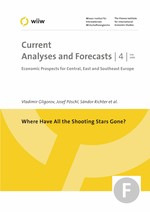Where Have All the Shooting Stars Gone?
Vasily Astrov, Vladimir Gligorov, Peter Havlik, Mario Holzner, Gabor Hunya, Michael Landesmann, Sebastian Leitner, Zdenek Lukas, Anton Mihailov, Olga Pindyuk, Leon Podkaminer, Josef Pöschl, Sandor Richter, Waltraut Urban and Hermine Vidovic
wiiw Current Analyses and Forecasts No. 4, July 2009
171 pages including 47 Tables and 50 Figures
You can also download separate country reports of this report
| No. | Title | Author | |
|---|---|---|---|
| 1 | Albania: you too my son? | Mario Holzner | Free Download |
| 2 | Baltic States: squashed hopes in the realm of depression | Sebastian Leitner | Free Download |
| 3 | Bosnia and Herzegovina: relative stability | Josef Pöschl | Free Download |
| 4 | Bulgaria: countercyclical measures help mitigate the shocks of the crisis | Anton Mihailov | Free Download |
| 5 | China: economy showing signs of bottoming out | Waltraut Urban | Free Download |
| 6 | Croatia: servicing foreign debt remains major weak point | Hermine Vidovic | Free Download |
| 7 | Hungary: little manoeuvring room to cope with the recession | Sandor Richter | Free Download |
| 8 | Kazakhstan: slipping into a mild recession | Olga Pindyuk | Free Download |
| 9 | Macedonia: lack of clarity | Vladimir Gligorov | Free Download |
| 10 | Montenegro: stability in crisis | Vladimir Gligorov | Free Download |
| 11 | Poland: resisting recession | Leon Podkaminer | Free Download |
| 12 | Romania: contraction in all fields | Gabor Hunya | Free Download |
| 13 | Russia: heading for crash and clash? | Peter Havlik | Free Download |
| 14 | Serbia: continuous deterioration | Vladimir Gligorov | Free Download |
| 15 | Slovakia: late revenge of the overambitious conversion rate | Zdenek Lukas | Free Download |
| 16 | Slovenia: hit hard despite recovery package | Hermine Vidovic | Free Download |
| 17 | The Czech Republic: policy eased to limit the damage | Leon Podkaminer | Free Download |
| 18 | Turkey: a show of confidence - or a struggle for survival? | Josef Pöschl | Free Download |
| 19 | Ukraine: back to external equilibrium | Vasily Astrov | Free Download |
The report analyses recent economic developments and short- and medium-term prospects of the countries of Central and Eastern Europe, Southeast Europe including Turkey, as well as Kazakhstan, Russia, Ukraine and China. Separate chapters present an overview of developments in the European Union's new member states and in the future EU member states of Southeast Europe, and deal with the changing role of the IMF in the region and the latest developments in foreign trade.
Reference to wiiw databases: wiiw Annual Database, wiiw Monthly Database
Keywords: Central and East European, new EU member states, Southeast Europe, future EU member states, Balkans, former Soviet Union, China, Turkey, economic forecasts, GDP growth, exchange rates, inflation, EU integration, foreign trade, financial markets, fiscal policy, financial crisis
JEL classification: G01, G18, O52, O57, P24, P27, P33, P52
Countries covered: Albania, Asia, Bosnia and Herzegovina, Bulgaria, Visegrad countries, China, CIS, Croatia, Czechia, Estonia, European Union, Hungary, Kazakhstan, Latvia, Lithuania, North Macedonia, Montenegro, New EU Member States, Poland, Romania, Russia, SEE, Serbia, Slovakia, Slovenia, Turkey, Ukraine, Wider Europe, Central, East and Southeast Europe, Baltic States
Research Areas: Macroeconomic Analysis and Policy, International Trade, Competitiveness and FDI, Sectoral studies
